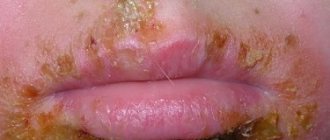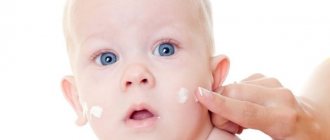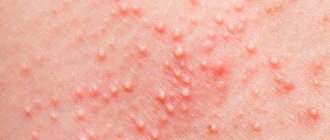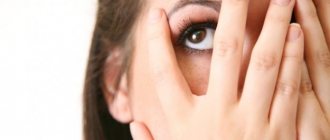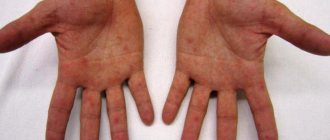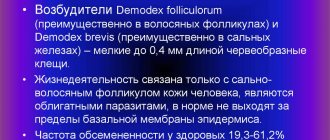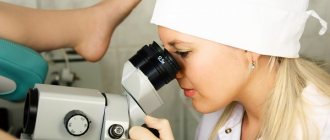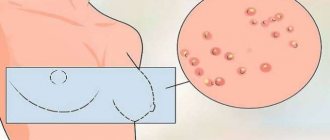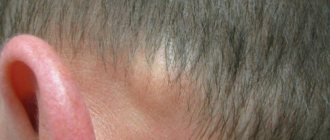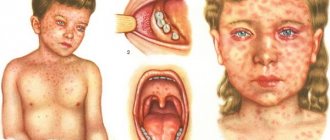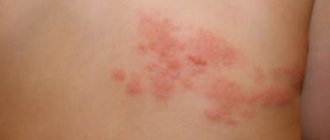November 22, 2016
Averyanova Sveta
Miliaria in a newborn is a skin irritation that arises and develops due to increased sweating in case of overheating of the body. It is not difficult to understand what prickly heat in newborns looks like.
A person can develop heat rash at any time, regardless of age, but heat rash often develops in infants.
This means that as soon as the baby overheats, his body immediately tries to get rid of excess heat by secreting sweat.
But in infants, the excretory channels of the sweat glands are still poorly developed, so they cannot effectively fulfill their purpose, thus, sweat accumulates at the mouths of the glands and irritates areas of the skin.
What does heat rash look like in newborns?
A rash on the body can be symptoms of an allergy, so parents need to know what prickly heat looks like in infants. Rashes on the baby’s body may appear in the first days of life or develop later. Most often the genital area is affected due to constant contact with a diaper; irritation rarely appears on the face of a newborn.
Parents observe that the skin with prickly heat first becomes red, later small pimples appear on it, which can be white or red, depending on the form of the disease. If the skin disease is not treated in a timely manner, it can lead to infection of the wounds . Miliaria is most often observed in babies;
- Prone to obesity;
- Premature;
- If you have diabetes.
Baby's skin does not tolerate synthetic fabrics well, so they need to choose everything natural. A more specific description of prickly heat can be obtained by studying its types. Even if parents know what newborn heat rash looks like, a visit to the doctor is necessary to confirm it and prescribe the correct treatment.
Products for treating rashes on the face
After determining the causes of the disease and understanding what type of prickly heat the child has, you can begin to treat the skin with safe products. To prevent the child from scratching and combing his facial skin, special anti-scratch pads are placed on his hands.
The most popular local remedies include:
- Syntomecin. The ointment is applied with a cotton swab to each pimple and is used for pustular formations due to staphylococcal infection. In mild forms of the disease, there is no need for this remedy.
- Bepaten. Skin-restoring ointment, applied in a thin layer several times a day. Used for irritated, scratched and dry skin. A 2% solution of boric acid is prescribed only after the recommendation of a doctor. Each pimple is treated separately using a cotton swab. Apply to large damaged areas to artificially dry the skin.
- Panthenol. Used as a regenerating agent.
- Zinc ointment. Applied to the skin several times a day, it has a disinfecting antiseptic effect.
- Furacilin or Levomycetin. Dissolve 3 tablets in 1 tbsp. water and moisten the affected areas with a cotton pad.
- Bleeding wounds are cauterized with brilliant green or iodine and open purulent pimples are disinfected.
- Levomycytin ointment relieves inflammation and has a disinfecting effect.
Symptoms of prickly heat in children
Only the beginning of prickly heat does not bring discomfort to the newborn. If it is not eliminated, the baby begins to scratch his skin, often cries, is capricious, and sleeps restlessly. It is not difficult to identify prickly heat; its characteristic symptoms are:
- Multiple rashes on the body, with liquid contents;
- Redness of inflamed skin;
- Localization of bubbles in areas of increased sweating;
- Itching of damaged skin.
When the blisters burst, the skin in their place acquires a rough surface, after which suppuration and infection are possible. Miliaria itself is not dangerous; the consequences occur depending on how long the parents did not take measures to eliminate it.
Adults are interested in how long the heat rash lasts; it depends on how early treatment is started and the factors that provoke it are eliminated. Miliaria usually goes away within 2-3 days, provided hygiene rules are followed and there is no overheating. If the rash does not disappear longer, it may have another origin.
Doctors do not consider heat rash to be a disease for a newborn; it is more equated with ordinary irritation. Most often, the rash appears in hot weather; in the summer, the baby needs special care. There have been cases where a minor rash in children disappeared within a few hours after bathing in baths with wound-healing herbs.
Treatment of purulent heat rash
In the case of a purulent rash or blisters up to 3 mm in diameter, conventional methods are unlikely to help. Of course, you start with drying and baths, but purulent heat rash itself in newborns requires specific treatment:
- First of all, you need to determine the nature of the infection: fungal or bacterial. Depending on the results of the analysis, an ointment is prescribed, and maybe even an antibiotic;
- The main thing is to prevent the rash from spreading and the blisters being scratched. To do this, the baby needs to wear scratchies or blouses with closed arms.
If you notice that prickly heat does not go away, despite all your efforts, but also increases in size and changes its appearance, then you cannot do without the help of a specialist.
- How to wash a newborn girl and boy?
- Vaseline oil for a newborn
- How to treat a newborn's navel?
Causes of prickly heat
Wrapping your baby up tightly can cause heat rash
When a rash occurs in their firstborn, many mothers do not know what to do. Knowing the reasons for its formation, it will be easier for parents to prevent the appearance of prickly heat in their newborn. Considering that babies have very sensitive skin, irritation appears very quickly. Properly selected clothing for a newborn will greatly reduce the development of the disease; it should be made of soft natural fabrics that do not prevent air from entering. The appearance of prickly heat can be caused by:
- Wrapping up the baby, which causes overheating;
- High fever in a newborn;
- Finding a child in a stuffy room;
- Daily use of creams that clog pores;
- Internal characteristics of the body;
- Lack of proper care.
Irritation on the face may appear after sleep, in places of contact with the pillow. It will be easier to determine the nature of the rash if you know why and how prickly heat manifests itself.
- Neck - Heat rash in the cervical area can occur due to extreme heat and poor hygiene.
- Back - Mostly prickly heat occurs in the area of the shoulder blades, the reasons for this are overheating and wearing synthetic clothing.
- Face - Irritation on the face mainly spreads from the neck, but more often it indicates a rash of a different origin.
- Head - Pimples rarely appear on the baby’s head; they are mainly caused by wearing a cap in a hot room.
- Buttocks - Irritation in the buttocks area is caused by constant wearing of diapers and the use of creams with a fatty composition.
Miliaria is not contagious, it is not transmitted between children, so the baby can safely go to kindergarten. If an infection is suspected, the pediatrician will not allow it; treatment will be prescribed, after which a certificate will be issued.
How to get rid of heat rash in a newborn?
Treatment of heat rash in newborns should begin at the first symptoms. Then the baby will easily and without consequences cope with the disease. To eliminate symptoms, it is recommended to use ointments and creams, which include:
- Zinc oxide;
- Chlorhexidine;
- Dexpanthenol.
Pharmaceutical, not very concentrated solutions are used as antiseptics. The baby is bathed in medicinal herbs and wiped dry before dressing or swaddling. Powder is used, ointments and creams are applied to the areas of the rash and allowed to absorb well; the preparations can be mixed with healing baby creams.
How to treat heat rash in a baby?
It is recommended to treat prickly heat in newborns after consulting a pediatrician; the following drugs are generally prescribed.
- Fenistil - Finistil in the form of a gel helps against heat rash in newborns. It eliminates itching and prevents the appearance of new rashes.
- Chlorophyllipt - The drug will help quickly eliminate rashes, but it has contraindications. It is used with caution for children with stool disorders; it can cause allergies.
- Desitin - Cream helps to quickly get rid of irritation caused by wet diapers. It dries out pimples and has an antiseptic and adsorbing effect. Not suitable for children with very sensitive skin.
- Bepanten - You can cure the baby with Bepanten cream, it helps to quickly remove rashes and has no contraindications.
- Depanthenol - The drug accelerates skin regeneration, as a result of which prickly heat in infants quickly disappears. It has an anti-inflammatory and calming effect.
- Pantoderm - Cream helps to quickly get rid of rashes. Heals infected skin lesions.
When inflammations become infected, antibiotic ointments are used. The skin can be treated with a weak solution of manganese and boric acid. You can combat severe itching with antihistamines:
- Loratadine;
- Desloratadine;
- Cetrina.
Prevention and treatment involves the use of herbal baths and the use of some folk recipes internally.
Complications
If the symptoms are not eliminated, the disease progresses to vesiculopustulosis. It manifests itself as purulent blisters, with crusts forming after they burst. Complications can be in the form of:
- otitis;
- pneumonia;
- omphalitis;
- pyeloniphritis.
The most dangerous complication after vesiculopustelesis is sepsis. The baby becomes weak, has a high temperature, and stops breastfeeding. Elimination of purulent diseases in children is always carried out in the hospital; in such situations, the doctor prescribes antibacterial therapy and detoxification drips if necessary.
Alternative medicine
Traditional medicine for heat rash
Many parents are of the opinion that a newborn needs everything natural. Therefore, they want to know how to treat prickly heat with folk remedies.
- Bay leaf - To avoid drying out the baby's skin when bathing with manganese, you can use a decoction of bay leaves, which have a bacterial effect.
- Soda - Itching of the skin will disappear if you treat it with a pasty solution of soda, 20 g. per glass of liquid.
- Herbal infusions for bathing
Our grandmothers knew how to get rid of prickly heat in a newborn child quickly and without consequences; they fought the rash using baths with infusions of medicinal herbs:
- Chamomile;
- Series;
- Sage;
- Yarrow;
- Celandine;
- Oak bark.
The plants are added to a thermos in the amount of one spoon of dry mixture, poured with 1 liter of boiling water and allowed to brew for at least half an hour.
How to distinguish heat rash from allergies?
Skin irritation does not always indicate prickly heat; in order to prescribe the correct treatment, it must be differentiated from other types of rash. It is often confused with eczema and allergies, which, unlike infant heat, is characterized by growing red spots. Allergies from heat rash in newborns are distinguished by the following characteristics.
Manifestation of allergies
Rashes in a one-month-old baby do not depend on overheating. The pimples are red with liquid inside; when they merge, they form areas with a rough surface. Treatment consists of eliminating the allergen and taking antiallergic medications that quickly eliminate symptoms.
Prickly heat
The onset of symptoms occurs after the newborn sweats. A rash in the form of small blisters, often flesh-colored, red only with prickly heat, the skin does not peel off. Elimination of symptoms consists of drying the damaged areas of the skin and regular bathing. Medicines are required only in advanced cases.
Types of miliaria
According to the signs of the rash, there are 3 main types of miliaria:
- Crystalline. This is what is usually observed in infants. Signs: pearlescent or white blisters that merge with each other as the rash spreads. The size of the bubbles is about 2 mm. After the vesicles are damaged (a day or two), areas of peeling appear on the infant skin. Areas of distribution are the neck with the face and the upper half of the body.
- Red. Signs: tiny uniform nodules or blisters and noticeable redness of the skin around them. With this type of miliaria, the blisters do not merge, and at the sites of the rash there is pain when touched with fingers and itchy skin. In hot weather or high humidity, pain tends to intensify. The main areas of manifestation: the groin and armpits, skin folds on the neck.
- Deep. Signs: bubbles 1-3 mm in diameter (flesh color) on the arms/legs or torso. They appear after sweating - after an hour or two, and also quickly disappear.
If, in the presence of miliaria, an infection also settles on the skin, then we are talking about microbial eczema - that is, infected miliaria, which is characterized by the appearance of blisters with the presence of a cloudy liquid, redness of the skin and a rise in temperature.
Preventive measures
Bathing your baby will help avoid problems with heat rash
An infant's heat exchange has not yet been formed; parents believe that the baby is freezing; they begin to wrap him up and dress him warmly, which is absolutely not allowed. Mothers should know one rule in order to understand whether the child is warm or cold by touching the tip of his nose. Prevention measures for newborns are as follows:
- It is not recommended to keep a newborn in diapers for a long time; it is better to wear diapers only for a walk or at night.
- Child care should be good; the newborn should be bathed every day and several times a day in the summer. Soap is used no more than 3 times a week, preference is given to herbal infusions, and air baths are useful.
- The temperature in a newborn's room can be from 20 to 22 degrees, without drafts.
- A newborn should be dressed according to the weather to prevent overheating.
- Often the rash appears when the newborn is not allowed to dry thoroughly after bathing and is wearing synthetic clothing that does not absorb moisture.
Adequate care will reduce the risk of heat rash in newborns and quickly eliminate its symptoms when it appears. To prevent infection from scratching the rash, infants should cut their nails short or wear scratchers. If the parents have taken all measures to eliminate prickly heat, but the rash does not disappear, the blisters change color and the size of the spots becomes larger, it is necessary to immediately go to the hospital.
Prevention
It is easier to prevent a disease than to think about how to treat it, as popular wisdom advises. Indeed, it is worth paying more attention to the prevention of prickly heat, thereby reducing the likelihood of its occurrence.
- Don't keep your baby in diapers. Despite what the advertisements say, diapers make it difficult for air to reach the skin and make them very hot. It is better to use diapers only for walks and for nighttime sleep. Use diaper cream;
- Wash after every bowel movement. Use plain water or baby wipes, then treat the folds with talcum powder;
- Maintain an optimal room temperature of 20-22 degrees. It is quite enough for the baby to feel normal, the main thing is to avoid drafts;
- Dress for the weather. Do not wrap your baby indoors or when going for a walk. It’s easy to determine if a child is cold or if he has enough warmth - just touch his nose. A cool nose means the baby is cold, a warm nose means the baby is comfortable, a hot nose means it’s hot;
- Baby clothes and bedding are only cotton and natural fabrics. Synthetics are not suitable for newborns; they make you sweat;
- Bathe your baby every day. You shouldn’t use soap for every bath, it washes off the protective film, but use as many herbal decoctions as you like.
- Arrange air baths. This is a wonderful hardening procedure, but also an excellent prevention of prickly heat.
